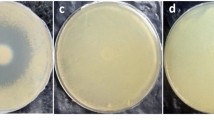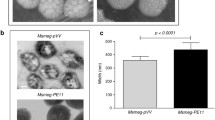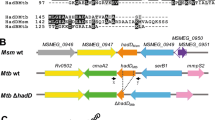Abstract
Discovery of novel secreted enzymes and proteins in Mycobacterium tuberculosis (M. tuberculosis) are imperative to understanding the pathogenic system for pathogenesis requires attention. Till date, the groups of these secreted enzymes are not meaningfully characterized in terms of M. tuberculosis. In this way, cutinase, a small lipolytic protein, exists in both bacteria and fungi as well which have a potential catalytic activity. During our search, we have found a few genes of M. tuberculosis demonstrating a same significant lipase action as fungi Fusarium solani cutinase contain. Genome sequencing of M. tuberculosis uncover a lot of proteins, wherein (Rv1758, Rv1984c, Rv2301, Rv3451, Rv3452, Rv3724A, Rv3724B, and Rv3802c) genes have been noted which are exhibiting a cutinase-like activity and closely homologous to that of F. solani cutinase and having the ability to hydrolyze model substrates including p-nitrophenyl butyrate (p-PNB), cutin, triacylglycerols (TAGs), and triolein (TO), yet their biological significance in pathogenesis stays subtle and uncharacterized. In a basic perspective, the measure of cutinase expressed by M. tuberculosis and part of these small lipolytic enzymes in the pathologic discipline require thorough characterization. So, through focusing on cutinase-encoding genes in M. tuberculosis and their active catalytic motif could help to build up a novel therapeutic approach.



Similar content being viewed by others
Abbreviations
- M. tuberculosis :
-
Mycobacterium tuberculosis
- F. solani :
-
Fusarium solani
- T. fusca :
-
Thermomonospora fusca
- P. spp.:
-
Pseudomonas spp.
- Culp:
-
Cutinase-like proteins
- Cut:
-
Cutinase
- TO:
-
Triolein
- LDs:
-
Lipid droplets
- TAGs:
-
Triacylglycerols
References
Mukhopadhyay, S., Nair, S., & Ghosh, S. (2012). Pathogenesis in tuberculosis: transcriptomic approaches to unraveling virulence mechanisms and finding new drug targets. FEMS Microbiology Review, 36, 463–485.
TB India .Revised National TB control Programme (2013) Annual report, Central TB Division, govt. of India.
Global tuberculosis report 2014. http://www.who.int/tb/publications/global_report/en/
Kumari, P., & Meena, L. S. (2014). Factors affecting susceptibility to Mycobacterium tuberculosis: a close view of immunological defence mechanism. Applied Biochemistry and Biotechnology, 174, 2663–2673.
Kandola, P., & Meena, L. S. (2014). Extra pulmonary tuberculosis: overview, manifestations, diagnostic and treatment techniques. Advance Material Reviews, 1, 13–19.
Wilson, J. W., Schurr, M. J., LeBlanc, C. L., Ramamurthy, R., Buchanan, K. L., & Nickerson, C. A. (2002). Mechanisms of bacterial pathogenicity. Postgraduate Medical Journal, 78, 216–224.
Pasula, R., Wisniowski, P., & Martin, W. J. (2002) Fibronectin Facilitates Mycobacterium tuberculosis Attachment to Murine Alveolar Macrophages. Infection and immunity, 70, 1287–1292.
Andersen, A. B., Andersen, P., & Ljungqvist, L. (1992). Structure and function of a 40,000-molecular-weight protein antigen of Mycobacterium tuberculosis. Infection and Immunity, 60, 2317–2323.
Koul, A., Herget, T., Klebl, B., & Ullrich. (2004). Interplay between mycobacteria and host signalling pathways. Nature Reviews Microbiology, 2, 189–202.
Maarten, R. E., & Jacob, V. (2000). Fusarium solani pisi cutinase. Biochimie, 82, 1015–1021.
Nyyssola, A., Pihlajaniemi, V., Jarvinen, R., Mikander, S., Kontkanen, H., Kruus, K., Kallio, H., & Buchert, J. (2013). Screening of microbes for novel acidic cutinases and cloning and expression of an acidic cutinase from Aspergillus niger CBS 513.88. Enzyme Microbiol Technology, 52, 272–278.
Fett, W. F., Gerard, H. C., Moreau, R. A., Osman, S. F., & Jones, L. E. (1992). Cutinase production by Streptomyces spp. Current Microbiology, 25, 165–171.
Anja, RA. and Heise, PA. (2010) Oxireductases in the enzymatic synthesis of water-soluble conducting polymers (Ochoteco E and Mecerreyes D. eds). Technology & Engineering pp. 150. Springer.
Fett, W. F., Wijey, C., Moreau, R. A., & Osman, S. F. (1999). Production of cutinase by Thermomonospora fusca ATCC 27730. Journal of Applied Microbiology, 86, 561–568.
Sebastian, J., & Chandra, A. K. (1987). Discovery of a cutinase-producing Pseudomonas sp. cohabiting with an apparently nitrogen-fixing Corynebacterium sp. in the phyllosphere. Journal of Bacteriology, 169, 131–136.
Meena, L. S., & Kolattukudy, P. E. (2013). Expression and characterization of Rv0447c product as the methyltransferase involved in tuberculostearic acid biosynthesis in Mycobacterium tuberculosis. Biotechnology and Applied Biochemistry, 60, 412–416.
Meena, L. S. (2015). An overview to understand the role of PE_PGRS family proteins in Mycobacterium tuberculosis H37Rv and their potential as new drug targets. Biotechnology and Applied Biochemistry, 62, 145–153. doi:10.1002/bab.1266.
Meena, L. S., & Meena, J. (2015). Cloning and characterization of a novel PE_PGRS60 protein (Rv3652) of Mycobacterium tuberculosis H37Rv, exhibiting fibronectin binding property. Biotechnology and Applied Biochemistry. doi:10.1002/bab.1411.
Sebastian, J., & Kolattukudy, P. E. (1988). Purification and characterization of cutinase from a fluorescent Pseudomonas putida bacterial strain isolated from phyllosphere. Archives of Biochemistry and Biophysics, 263, 77–85.
Fett, W. F., Gerard, H. C., Moreau, R. A., Osman, S. F., & Jones, L. E. (1992). Screening of non-filamentous bacteria for production of cutin-degrading enzymes. Applied and Environmental Microbiology, 58, 2123–2130.
Rajni, Rao, N., & Meena, L. S. (2011). Biosynthesis and virulent behavior of lipids produced by Mycobacterium tuberculosis: lam and cord factor: an overview. Biotechnology Research International, 2011, 1–7.
Longhi, S., Zjzek, M. C., Lamizin, V., Icolas, A. N., & Cambillau, C. (1997). Atomic resolution (1.0 Å) crystal structure of Fusarium solani cutinase: stereo chemical analysis”. Journal of Molecular Biology, 268, 779–799.
Melo, E. P., Aires-Barros, M. R., & Cabral, J. M. S. (1995). Triglyceride hydrolysis and stability of a recombinant cutinase from Fusarium solani in AOT iso-octane reversed micelles. Applied Biochemistry and Biotechnology, 50, 45–56.
Purdy, R. E., & Kolattukudy, P. E. (1975). Hydrolysis of plant cuticle by plant pathogens. Purification, amino acid composition, and molecular weight of two isozymes of cutinase and a nonspecific esterase from Fusarium solani f. pisi. Biochemistry, 14, 2824–2831.
Purdy, R. E., & Kolattukudy, P. E. (1975). Hydrolysis of plant cuticle by plant pathogens. Properties of cutinase I, cutinase II, and a nonspecific esterase isolated from Fusarium solani pisi. Biochemistry, 13, 2832–2840.
Lin, T. S., & Kolattukudy, P. E. (1980). Isolation and characterization of a cuticular polyester (cutin) hydrolyzing enzyme from phytopathogenic fungi. Physiological Plant Pathology, 17, 1–4.
Antzig, A. H., Zuckerman, S. H., & Andonov-Roland, M. M. (1986). Isolation of a Fusarium solani mutant reduced in cutinase activity and virulence. Journal of Bacteriology, 168, 911–916.
Murphy, C. A., Cameron, J. A., Huang, S. J., & Vinopal, R. T. (1996). Fusarium polycaprolactone depolymerase is cutinase. Applied and Environmental Microbiology, 62, 2456–2460.
Carvalho, C. M. L., Aires-Barros, M. R., & Cabral, J. M. S. (1998). Cutinase structure, function and biocatalytic applications. Process Biotechnology, 1, 0717–3458.
Soliday, C. L., & Kolattukudy, P. E. (1983). Primary structure of the active site region of fungal cutinase, an enzyme involved in phytopathogenesis. Biochemical and Biophysical Research Communications, 114, 1017–1022.
Deb, C., Daniel, J., Tatiana, D. S., Abomoelak, B., Dubey, V. S., & Kolattukudy, P. E. (2006). A novel lipase belonging to the hormone-sensitive lipase family induced under starvation to utilize stored triacylglycerol in Mycobacterium tuberculosis. Journal of Biological Chemistry, 281, 3866–3875.
Vir, P., Gupta, D., Agarwal, R., & Verma, I. (2014). Interaction of alveolar epithelial cells with CFP21, a mycobacterial cutinase-like enzyme. Molecular and Cellular Biochemistry, 396, 187–199.
Verma, D. Das, L. Gambhir, V. Dikshit, KL. and Varshney, GC (2015) Heterogeneity among homologs of cutinase-like protein Cut5 in Mycobacteria. PLoS ONE. 10, doi:10.1371/journal.pone.0133186.
West, N. P., Frances, M. E., Chow, E. J., Randall, J., & Britton, W. J. (2009). Cutinase-like proteins of Mycobacterium tuberculosis: characterization of their variable enzymatic functions and active site identification. FASEB Journal, 23, 1694–1704.
Parker, S. K., Curtin, K. M., & Vasil, M. L. (2007). Purification and characterization of mycobacterial phospholipase a: an activity associated with mycobacterial cutinase. Journal of Bacteriology, 189, 4153–4160.
Meena, L. S., Chopra, P., Vishwakarma, R. A., & Singh, Y. (2013). Biochemical characterization of an S-adenosyl-L-methionine dependent methyltransferase of Mycobacterium tuberculosis. Biological Chemistry, 394, 871–877.
West, N. P., Wozniak, T. M., Valenzuela, J., Feng, C. G., Sher, A., Ribeiro, J. M., & Britton, W. J. (2008). Immunological diversity within a family of cutinase-like proteins of Mycobacterium tuberculosis. Vaccine, 26, 3853–3859.
Willcocks, S., & Wren, B. W. (2014). Shared characteristics between Mycobacterium tuberculosis and fungi contribute to virulence. Future Microbiology, 9, 657–668.
Sultana, R., Tanneeru, K., & Guruprasad, L. (2011). The PE-PPE domain in mycobacterium reveals a serine a/b hydrolase fold and function: an in-silico analysis. PLoS ONE, 6, 1–7.
Lopes, D. B., Fraga, L. P., Fleuri, L. F., & Macedo, G. A. (2011). Lipase and esterase—to what extent can this classification be applied accurately. Ciencia e Tecnologia de Alimentos Campinas, 31, 608–613.
Flipsen, J. A., Van der Hijden, H. T., Egmond, M. R., & Verheij, H. M. (1996). Action of cutinase at the triolein-water interface. Characterisation of interfacial effects during lipid hydrolysis using the oil-drop tensiometer as a tool to lipase kinetics. Chemistry and Physics of Lipids, 84, 105–115.
Ashton Acton, Q. (2011) Advances in Mycobacterium research and application: scholarly editions, pp. 139. Atlanta, Georgia.
Egmond, M. R., & Vlieg, J. (2000). Fusarium solani pisi cutinase. Biochimie, 82, 1015–1021.
Weldingh, K., Rosenkrands, I., Jacobsen, S., Rasmussen, P. B., Elhay, M. J., & Andersen, P. (1998). Two-dimensional electrophoresis for analysis of Mycobacterium tuberculosis culture filtrate and purification and characterization of six novel proteins. Infection and Immunity, 66, 3492–3500.
Dedieu, L., Serveau-Avesque, C., & Canaan, S. (2013). Identification of residues involved in substrate specificity and cytotoxicity of two closely related cutinases from Mycobacterium tuberculosis. PLoS One, 8, 1–10.
Delorme, V., Diomande, S. V., Dedieu, L., Cavalier, J. F., Carriere, F., Kremer, L., Leclaire, J., Fotiadu, F., & Canaan, S. (2012). MmPPOX inhibits Mycobacterium tuberculosis lipolytic enzymes belonging to the hormone-sensitive lipase family and alters mycobacterial growth. Plos One, 7, 1–9.
Low, K. L., Shui, G., Natter, K., Yeo, W. K., Kohlwein, S. D., Dick, T., Rao, S. P. S., & Wenk, M. R. (2010). Lipid droplet-associated proteins are involved in the biosynthesis and hydrolysis of triacylglycerol in Mycobacterium bovis Bacillus Calmette-Guerin. Journal of Biological Chemistry, 285, 21662–21670.
Listenberger, L. L., Ostermeyer-Fay, A. G., Goldberg, E. B., Brown, W. J., & Brown, D. A. (2007). Adipocyte differentiation-related protein reduces the lipid droplet association of adipose triglyceride lipase and slows triacylglycerol turnover. Journal of Lipid Research, 48, 2751–2761.
Peyron, P., Vaubourgeix, J., Poquet, Y., Levillain, F., Botanch, C., Bardou, F., Daffe, M., Emile, J. F., Marchou, B., Cardona, P. J., Chastellier, C., & Altare, F. (2008). Foamy macrophages from tuberculous patients’ granulomas constitute a nutrient-rich reservoir for M. tuberculosis persistence. PLoS Pathogen, 4(11), e1000204.
Ohsaki, Y., Suzuki, M., & Fujimoto, T. (2014). Open questions in lipid droplet biology. Chemistry & Biology, 21, 86–96.
Chang, B. H., Li, L., Paul, A., Taniguchi, S., Nannegari, V., Heird, W. C., & Chan, L. (2006). Protection against fatty liver but normal adipogenesis in mice lacking adipose differentiation-related protein. Molecular Cell. Biology, 26, 1063–1076.
Kadereit, B., Kumar, P., Wang, W. J., Miranda, D., Snapp, E. L., Severina, N., Torregroza, I., Evans, T., & Silver, D. L. (2008). Evolutionarily conserved gene family important for fat storage. Proceedings of the National Academy of Sciences, 105, 94–99.
Singh, V., Jamwal, S., Jain, R., Verma, P., Gokhale, R., & Rao, K. V. S. (2012). Mycobacterium tuberculosis-driven targeted recalibration of macrophage lipid homeostasis promotes the foamy phenotype. Cell press, 12, 669–681.
Chaban, V. V., & Khandelia, H. (2014). Lipid structure in triolein lipid droplets. Journal of Physical Chemistry B, 118, 10335–10340.
Bickel, P. E., Tansey, J. T., & Welte, M. A. (2009). PAT proteins, an ancient family of lipid droplet proteins that regulate cellular lipid stores. Biochimica et Biophysica Acta, 1791, 419–440.
Daniel, J., Deb, C., Dubey, V. S., Sirakova, T. D., Abomoelak, B., Morbidoni, H. R., & Kolattukudy, P. E. (2004). Induction of a novel class of diacylglycerol acyltransferases and triacylglycerol accumulation in Mycobacterium tuberculosis as it goes into a dormancy-like state in culture. Journal of Bacteriology, 186, 5017–5030.
Schue, M., Maurin, D., Dhouib, R., Bakala N’Goma, J. C., Delorme, V., Lambeau, G., Carriere, F., & Canaan, S. (2010). Two cutinase-like proteins secreted by Mycobacterium tuberculosis show very different lipolytic activities reflecting their physiological function. FASEB Journal, 24, 1893–1903.
Cole, S. T., Brosch, R., Parkhill, J., Garnier, T., Churcher, C., Harris, D., Gordon, S. V., Eiglmeier, K., Gas, S., Barry, C. E., Tekaia, F., Badcock, K., Basham, D., Brown, D., Chillingworth, T., Connor, R., Davies, R., Devlin, K., Feltwell, T., Gentles, S., Hamlin, N., Holroyd, S., Hornby, T., Jagels, K., Krogh, A., McLean, J., Moule, S., Murphy, L., Oliver, K., Osborne, J., Quail, M. A., Rajandream, M. A., Rogers, J., Rutter, S., Seeger, K., Skelton, J., Squares, R., Squares, S., Sulston, J. E., Taylor, K., Whitehead, S., & Barrell, B. G. (1998). Deciphering the biology of Mycobacterium tuberculosis from the complete genome sequence. Nature, 393, 537–544.
Meena, L. S., & Rajni. (2010). Survival mechanisms of pathogenic Mycobacterium tuberculosis H37Rv. FEBS Journal, 277, 2416–2427.
Rajni, and Meena, LS. (2011) Unique characteristic features of Mycobacterium tuberculosis in relation to immune system. Am. J. Immunol. 2011, 7: 1–8.
Segovia-Juarez, J. L., Ganguli, S., & Kirschner, D. (2004). Identifying control mechanisms of granuloma formation during M. tuberculosis infection using an agent-based model. Journal of Theoretical Biology, 231, 357–376.
Dang, G., Chen, L., Li, Z., Deng, X., Cui, Y., Cao, J., Yu, S., Pang, H., & Liu, S. (2015). Expression, purification and characterisation of secreted esterase Rv2525c from Mycobacterium tuberculosis. Applied Biochemistry and Biotechnology, 176, 1–12.
Pandey, A. K., & Sassetti, C. M. (2008). Mycobacterial persistence requires the utilization of host cholesterol. Proceedings of the National Academy of Sciences of the United States of America, 105, 4376–4380.
Meena, P. R., Monu, & Meena, L. S. (2015). Fibronectin binding protein and Ca2+ play an access key role to mediate pathogenesis in Mycobacterium tuberculosis: an overview. Biotechnolnology Aplicada Biochemistry. doi:10.1002/bab.1434.
Gengenbacher, M., & Kaufmann, S. H. (2012). Mycobacterium tuberculosis: success through dormancy. FEMS Microbiology Reviews, 36, 514–532.
Riahi, F., Derakhahan, M., Mosavat, A., Soleimanpour, S., & Rezaee, S. A. (2015). Evaluation of point mutation detection in Mycobacterium tuberculosis with isoniazid resistance using real-time PCR and TaqMan probe assay. Applied Biochemistry and Biotechnology, 175, 2447–2455.
Acknowledgments
We thank Dr. Rajesh S. Gokhale for making this work possible. The authors acknowledge the financial support from GAP0092 of the Department of Science and Technology (DST) and OLP1121of the Council of Scientific & Industrial Research (CSIR).
Author information
Authors and Affiliations
Corresponding author
Ethics declarations
Conflict of Interest
The authors declare that they have no competing interests.
Rights and permissions
About this article
Cite this article
Monu, Meena, L.S. Roles of Triolein and Lipolytic Protein in the Pathogenesis and Survival of Mycobacterium tuberculosis: a Novel Therapeutic Approach. Appl Biochem Biotechnol 178, 1377–1389 (2016). https://doi.org/10.1007/s12010-015-1953-z
Received:
Accepted:
Published:
Issue Date:
DOI: https://doi.org/10.1007/s12010-015-1953-z




